Welcome to the year 2027. The year where the net metering policy in the Netherlands stopped. This post is about owning a home battery system in 2027 onwards and the benefit it has financially, based on minute precise real-world usage- and solar data collected in 2024. In my previous blogpost about the Sessy Home Battery Experience, owning a home battery + dynamic contract resulted in €161.42 more annual profit than without a home battery and a fixed price contract. The calculations showed a ~41 years return on investment for a 10kWh system. Starting 2027 this will change. How this will have an effect, we’ll explore in this post.
What happens in 2027 / 2030?
The net metering policy will come to an end, meaning:
- Administratively subtracting electricity delivery from electricity usage is not allowed anymore.
- From 2027 until 2030 electricity suppliers must offer a compensation of minimally 50% of the bare delivery price.
- Starting 2030 electricity suppliers are free to choose the compensation of electricity delivery to the grid.
Without a home battery system
For example, taking the numbers from my last blogpost (without a home battery system), in the 2nd half of 2024 we had:
- 1576 kWh Grid Usage
- 1925 kWh Grid Delivery
- 570 kWh Solar Self-Consumption (26.6%)
- 2146 kWh Total Consumption
In the calculations below I’m doubling these numbers to account for 1 full year.
With a fixed price contract (€0.2642/kWh usage, €0.05/kWh delivery), in 2024 this meant:
- Costs: €0.00 (€0.2642/kWh, 0 kWh because of net metering policy)
- Profit: €34.90 (2x 1925 kWh - 1576 kWh x €0.05/kWh)
- Result: €34.90 annual profit
In 2027 this means:
- Costs: €832.76 (2x 1576 kWh x €0.2642/kWh)
- Profit: €255.16 (2x 1925 kWh x €0.066275/kWh)
- Result: €577.60 annual costs
€0.066275/kWh = 50% of "€0.2642 - €0.13165 energy taxes, including vat."
And in 2030 this means (using today’s delivery compensation of ~€0.03):
- Costs: €832.76 (2x 1576 kWh x €0.2642/kWh)
- Profit: €115.50 (2x 1925 kWh x €0.03/kWh)
- Result: €717.26 annual costs
So while still having an annual profit of €34.90 in 2024, in 2030 I will be paying €717.26 😱 (without a home battery system). Without solar panels I would be paying €1134.68 for 4292 kWh with a fixed contract. The profit of having solar panels is cut in half in 2027 and cut by 2/3rd’s in 2030.
Home Batteries to the rescue!
Will it financially become more attractive to have a home battery system in 2027?
In my previous blogpost I already shared actual real-life numbers when having 2 Sessy’s (10kWh) and running in Dynamic mode (Return On Investment) over the months of July-December 2024. It resulted in €98.16 profit (€196.32 annual), but this still took in account the net metering policy.
Without the net metering policy in 2027 this will look different:
- Costs: €963.82 (€0.2389/kWh calculated average)
- Profit: €440.66 (€0.1013/kWh calculated average)
- Result: €523.16 annual costs
Running the batteries in 2027 in Dynamic mode will result in €719.48 less profit. Compared to €577.60 costs without a battery, there’s only a benefit of €54.44 😬 when running in Dynamic mode‼️
Maximizing self-consumption w/ Zero-on-the-Meter
Instead of running in Dynamic mode, the batteries could run in Zero-on-the-Meter mode to maximize self-consumption. I simulated Zero-on-the-Meter mode for the same period, like I did in my blogpost about Simulating a Tesla Powerwall with InfluxDB.
To have a good comparison, these are the home consumption sources when running in Dynamic mode:
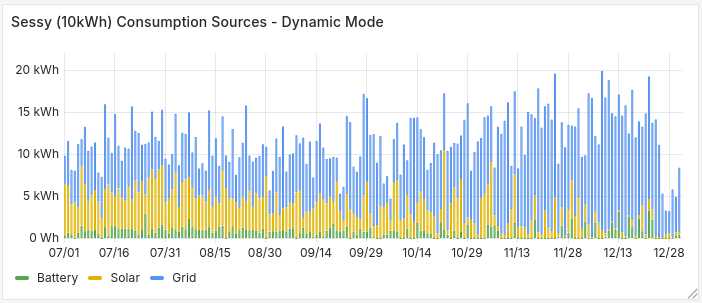
🔵 1440 kWh Grid Consumption
🟡 570 kWh Solar Self-Consumption
🟢 136 kWh Battery Self-Consumption
Dynamic mode resulted in a total self-consumption of 32.9%
10kWh battery in Zero-on-the-Meter Mode
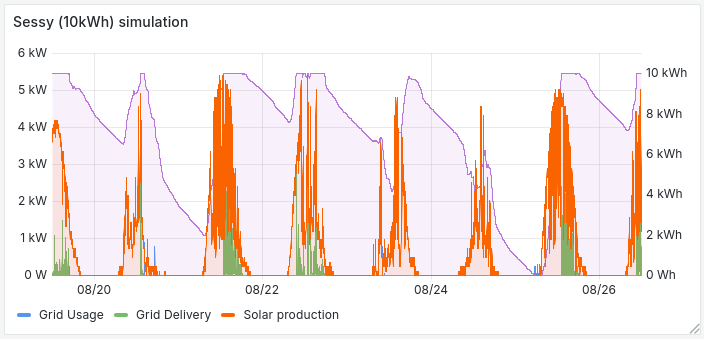
I simulated Zero-on-the-Meter mode with 2 Sessy’s (10kWh) and 85% Round Trip Efficiency. When you compare the graph below with the earlier graph, its clearly visible that there is major increase in the battery consumption source.
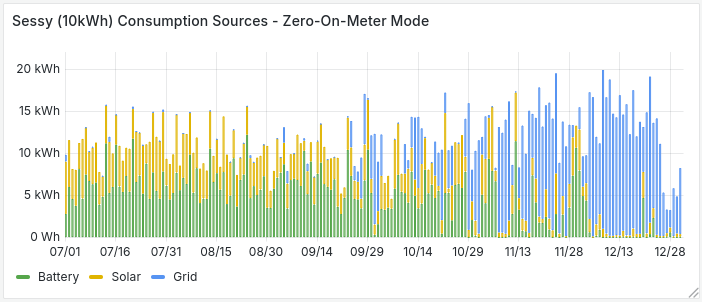
🔵 717 kWh Grid Consumption
🟡 570 kWh Solar Self-Consumption
🟢 844 kWh Battery Self-Consumption
Zero-on-the-Meter mode with 2 Sessy’s results in a total self-consumption of 65.9%. In my situation, a 10kWh home battery in Zero-on-the-Meter mode more than doubles the self-consumption of solar produced electricity.
And besides home consumption there is also still grid delivery of solar over-production:
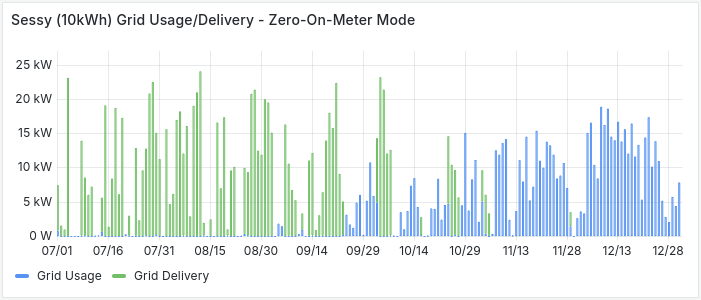
🔵 717 kWh Grid Usage
🟢 905 kWh Grid Delivery
Costs/profit in case of a dynamic contract in 2027 are:
- Costs: €400.80 (€0.2794/kWh calculated average)
- Profit: €47.30 (€0.0261/kWh calculated average)
- Result: €353.50 annual costs
Costs/profit in case of a fixed contract in 2027 are:
- Costs: €378.86 (2x 717 kWh x €0.2642/kWh)
- Profit: €119.94 (2x 905 kWh x €0.066275/kWh)
- Result: €258.90 annual costs
Costs/profit in case of a fixed contract in 2030 are:
- Costs: €378.86 (2x 717 kWh x €0.2642/kWh)
- Profit: €54.30 (2x 905 kWh x €0.03/kWh)
- Result: €324.56 annual costs
Compared to €577.60 annual costs without a battery in 2027, a 10kWh battery reduces the annual bill with €318.70 in Zero-on-the-Meter mode.
Compared to €717.26 annual costs without a battery in 2030, a 10kWh battery reduces the annual bill with €392.70 in Zero-on-the-Meter mode.
Starting in 2027, a 10kWh battery has a return on investment of ~17 years (€6650/392.70).
5kWh battery in Zero-on-the-Meter Mode
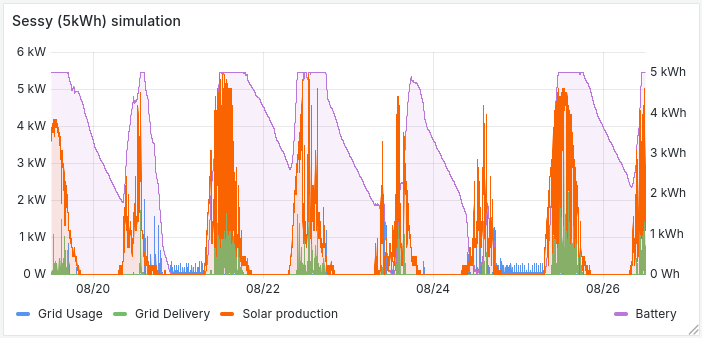
Now I became curious. What if you would do a smaller investment and go for 1x 5kWh Sessy. What is the benefit of having a 10kWh vs. a 5kWh battery?
The simulation also shows a significant increase of battery consumption:
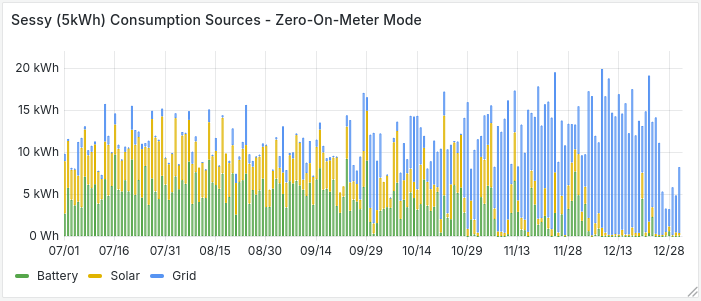
🔵 850 kWh Grid Consumption
🟡 570 kWh Solar Self-Consumption
🟢 711 kWh Battery Self-Consumption
Zero-on-the-Meter mode with 1 Sessy results in a total self-consumption of 59,7%. Not bad compared to 65.9% with 2 Sessy’s.
There is more grid delivery, but also more grid usage:
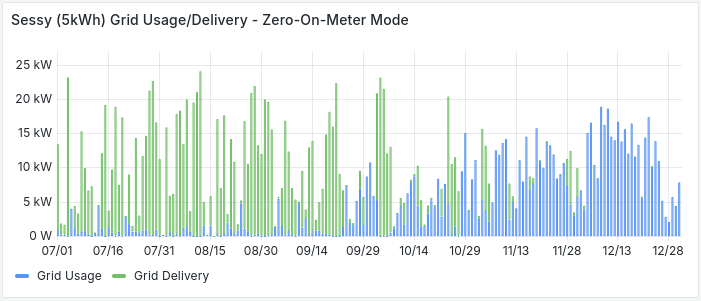
🔵 850 kWh Grid Usage
🟢 1057 kWh Grid Delivery
Costs/profit with a dynamic contract in 2027 are:
- Costs: €468.82 (€0.2757/kWh calculated average)
- Profit: €61.08 (€0.0289/kWh calculated average)
- Result: €407.74 annual costs
Costs/profit with a fixed contract in 2027 are:
- Costs: €449.14 (2x 850 kWh x €0.2642/kWh)
- Profit: €140.10 (2x 1057 kWh x €0.066275/kWh)
- Result: €309.04 annual costs
Costs/profit in case of a fixed contract in 2030 are:
- Costs: €449.14 (2x 850 kWh x €0.2642/kWh)
- Profit: €63.42 (2x 1057 kWh x €0.03/kWh)
- Result: €385.72 annual costs
Compared to €577.60 annual costs without a battery in 2027, a 5kWh battery reduces the annual bill with €268.56. That’s €50.12 less than with a 10kWh battery.
Compared to €717.26 annual costs without a battery in 2030, a 5kWh battery reduces the annual bill with €331.54. This is €61.16 less than with a 10kWh battery.
Interesting enough the differences between a 5kWh battery and a 10kWh battery is not that big.
Starting in 2027, a 5kWh battery has a return on investment of 10~12 years. (3250/331.54, 3250/268.56) 😮
Summarized
- The profit by only having solar panels is cut in half in 2027 and cut by 2/3rd’s in 2030
- Without solar panels: €1134.68 annual costs
- Only solar panels in 2024: €34.90 annual profit
- Only solar panels in 2027: €577.60 annual costs
- Only solar panels in 2030: €717.26 annual costs
- Running a home battery system in Dynamic mode (ROI) will not be interesting anymore, because without the net metering policy you won’t get a return on energy taxes and vat. for the electricity you deliver to the grid.
- Self-Consumption becomes important
- Zero-on-Meter with a 10kWh battery increases self-consumption to 65.9%
- Solar + 10kWh battery (ZoM) in 2027: €258.90 annual costs
- Solar + 10kWh battery (ZoM) in 2030: €324.56 annual costs
- A 10kWh battery has a return on investment of ~17 years
- Zero-on-Meter with a 5kWh battery increases self-consumption to 59,7%
- Solar + 5kWh battery (ZoM) in 2027: €309.04 annual costs
- Solar + 5kWh battery (ZoM) in 2030: €385.72 annual costs
- A 5kWh battery has a return on investment of 10~12 years
